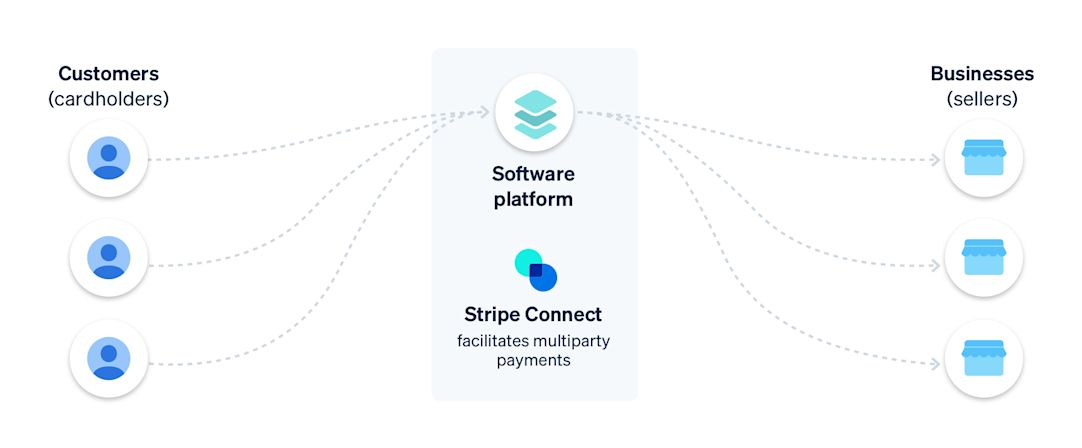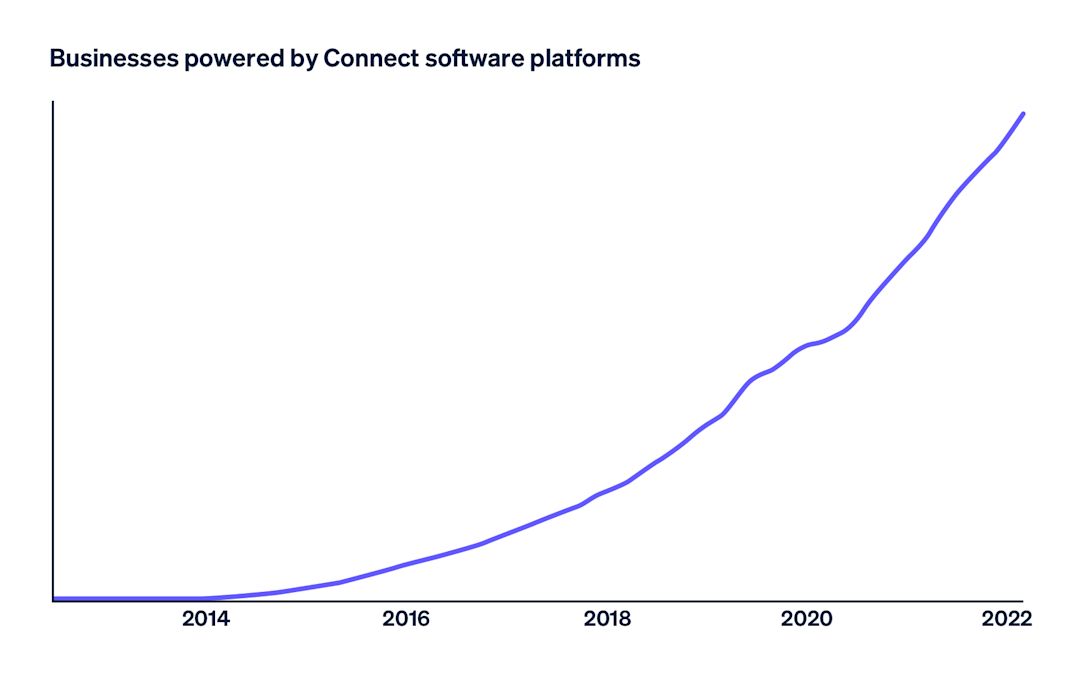Stripe Connect at 10: embedded finance and the next decade of software growth
- More than 10,000 software companies, marketplaces, and enterprises use Stripe Connect.
- Connect users power more than six million global businesses.
- Total payment volume processed by software platforms on Connect tripled over the last two years.
When we launched Stripe Connect 10 years ago, the relationship between software, payments, and financial services looked very different than it does today.
The software-as-a-service (SaaS) industry was still young and adoption was low: in 2011 (the year before Connect debuted), only 29% of small and midsize businesses (SMBs) used cloud-based services. Few of those services included integrated payments, and the idea that an SMB might turn to its software provider for banking services would have been, well, strange.
In short, SaaS, payments, and financial services were fragmented, with a lot of economic opportunity wasting in the cracks.
Fast forward a decade and that’s all changed.
Now there are thousands of SaaS solutions that offer specialized products for hundreds of lines of business and industry verticals, like Slice for independent pizzerias, SimplePractice for clinicians, and StyleSeat for salons. In turn, the majority of businesses run their entire operations on cloud-based SaaS products.
In a recent survey we conducted with Edgar, Dunn & Company, 67% of SMBs said they subscribe to at least one cloud-based software solution, 73% of those SMBs reported integrating payments with one or more of their software tools, and 65% replied that they’re likely to consider financial services offered by their software vendors.
The history of Connect is tightly interwoven with this dramatic shift. As Connect turns 10 years old, we want to share our perspective on what these changes mean and where we think this business ecosystem is headed.
Digital payments for all
Ten years ago, businesses that wanted to sell online had to first go through the time-consuming process of applying for a merchant account. And, if a software platform wanted to integrate payments into its products, it had to invest considerable resources building that infrastructure itself.
We created Connect to solve that.
Connect is a multiparty payments solution that lets software developers embed payments natively into their products. Connect users can quickly onboard businesses to allow them to take payments, create custom funds flows between customers and their business users, and pay out earnings.

A wide range of companies have adopted Connect, including marketplaces like Carvana, which uses Connect to power its online marketplace for used cars, and media platforms like Twitter and Spotify, which use Connect to let creators monetize their audiences. More recently, enterprises have been adopting Connect; Ford Motor Company will use Connect to expand its ecommerce infrastructure for both customers and dealers.
But the most dramatic changes have occurred around software platforms, which represent more than 60% of Connect users. They’ve transformed their business models by combining subscription revenue with payments monetization.
Powering software platforms and their users
Software companies that integrate Connect include the most popular commerce (Shopify), CRM (Salesforce), accounting (Xero), and omnichannel POS and commerce (Lightspeed Commerce) platforms, as well as platforms that serve specific industry verticals, from gyms (Mindbody) to nonprofits (Classy) to farms (Ambrook).
“A speedy, positive payments experience for customers online or in-store is crucial, and we want that to be something our merchants can always provide. Having a single solution for payments, POS, and commerce technology makes everything easier for our customers,” said Jona Georgiou, payments general manager at Lightspeed Commerce.
Platforms and businesses using Connect saw continued growth over the course of the pandemic. From March 2020 to March 2022, the number of businesses served by software platforms using Connect jumped 88%, and total payment volume processed across Connect software platforms more than tripled.

To highlight two examples, between FY2019 and FY2021, Shopify’s merchant solutions revenue, which includes payment processing services, grew by approximately 250%, to $3.3 billion—comprising 70% of the platform’s total revenue last year. And Podium, a customer interaction platform, saw major acceleration after it launched an integrated payments offering in March 2020.
“The combination of SaaS plus payments is really powerful. For many of our customers, who are local business owners, we are their core operating system, and payments is their most critical business process. By building an integrated payments offering, we are providing a tremendous amount of value to our customers and, in turn, we see higher retention on our platform overall,” said Alec Lovett, vice president of product and head of payments at Podium.
The next 10 years: SaaS, payments, and embedded financial services
As we look ahead, it seems clear that the next step for software platforms is the addition of embedded financial services: products like lending, cards, and financial accounts. It's a move that makes sense for platforms, whose SMB customers are eager to consolidate vendors and are often underserved by traditional banks. In our survey work with Edgar, Dunn & Company, 59% of SMBs said they are willing to pay more to work with a “one-stop shop” software vendor, and in a J.D. Power report, only 32% of small businesses reported that their bank understands their business.
Software companies–especially those that serve specific industry verticals–have deep familiarity with their customers and can provide financial services tailored to their needs, like prequalifying customers based on their payment histories or issuing expense cards so customers can spend funds earned from their sales.
Shopify, Lightspeed Commerce, and Jobber have been among the first platforms to extend their payments business with embedded financial services through Stripe. In doing so, they’ve tapped into a global addressable market opportunity that is estimated to be worth more than $7 trillion by 2030. That’s twice the combined value of the world’s top 30 banks today.
As Mark Assini, product marketing manager at Jobber notes, “The biggest and arguably longest-lasting trend in the SaaS space, with regard to fintech, is the increasing value these solutions can unlock for customers. This ever-increasing value is what makes fintech solutions like embedded payments, lending, consumer financing, and other financial services such a growing priority for SaaS companies.”
Connect: the new front door to embedded finance
When we launched Connect, our goal was to build “very broad economic infrastructure for the internet.” Ten years later, that goal stands, and now it means much more than payments. Today, Connect is positioned as a “front door” that grants access to the rapidly expanding world of embedded finance.
“As a SaaS operating system for local business, we see a natural opportunity to uplevel access to modern payments and, in the future, financial services. Stripe is a powerful accelerator to this strategy, and Connect allows us to deliver these services to our customers with a high return on their investment,” said Lovett.
The range of financial services that software platforms and their users can access through Connect is only growing. We’re making investments that will position Connect to help shape the next decade of software evolution as much as it has helped shape the last.
Learn more about Stripe for Software Platforms.
